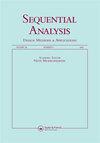Optimizing sample size in relative bioavailability trials using a Bayesian decision-theoretic framework
IF 0.6
4区 数学
Q4 STATISTICS & PROBABILITY
Sequential Analysis-Design Methods and Applications
Pub Date : 2020-04-02
DOI:10.1080/07474946.2020.1766887
引用次数: 0
Abstract
Abstract Bioequivalence (BE) trials are sometimes preceded by a pilot relative bioavailability (BA) trial to investigate whether the test formulation is sufficiently similar to the reference. The geometric mean ratio and its confidence bounds provide guidance as to how the BE trial can be appropriately sized to attain sufficient power. The aim of this work is to optimize the sample size of a pilot BA trial in order to minimize the overall sample size for the combination of pilot and pivotal trials. This is done through specification of a gain function associated with any of two possible outcomes of the trial; that is, abandon further development of the test formulation or proceed to a pivotal BE trial. The gain functions will be constructed on the basis of sample size considerations only, because subject numbers are indicative of both the cost and the feasibility of a clinical trial. Using simulations, it is demonstrated that for drugs with high intrasubject variability, the BA trial should be sufficiently sized to avoid erroneous decision making and to control the overall cost. In contrast, when the intrasubject variability of the pharmacokinetic (PK) parameters is low, not conducting the BA trial should be considered. It is concluded that the rather typical practice of conducting small pilot trials is unlikely to be a cost-effective approach.利用贝叶斯决策理论框架优化相对生物利用度试验的样本量
摘要生物等效性(BE)试验之前有时会进行中试相对生物利用度(BA)试验,以调查试验制剂是否与参考制剂足够相似。几何平均比及其置信区间为如何适当确定BE试验的大小以获得足够的功率提供了指导。这项工作的目的是优化试点BA试验的样本量,以最大限度地减少试点和关键试验组合的总体样本量。这是通过指定与试验的两种可能结果中的任何一种相关的增益函数来实现的;即放弃测试配方的进一步开发或进行关键的BE试验。增益函数将仅基于样本量考虑进行构建,因为受试者数量指示了临床试验的成本和可行性。通过模拟,证明了对于受试者内部变异性高的药物,BA试验的规模应该足够大,以避免错误的决策并控制总体成本。相反,当受试者体内药代动力学(PK)参数的变异性较低时,应考虑不进行BA试验。得出的结论是,进行小型试点试验的相当典型的做法不太可能是一种具有成本效益的方法。
本文章由计算机程序翻译,如有差异,请以英文原文为准。
求助全文
约1分钟内获得全文
求助全文
来源期刊

Sequential Analysis-Design Methods and Applications
STATISTICS & PROBABILITY-
CiteScore
1.40
自引率
12.50%
发文量
20
期刊介绍:
The purpose of Sequential Analysis is to contribute to theoretical and applied aspects of sequential methodologies in all areas of statistical science. Published papers highlight the development of new and important sequential approaches.
Interdisciplinary articles that emphasize the methodology of practical value to applied researchers and statistical consultants are highly encouraged. Papers that cover contemporary areas of applications including animal abundance, bioequivalence, communication science, computer simulations, data mining, directional data, disease mapping, environmental sampling, genome, imaging, microarrays, networking, parallel processing, pest management, sonar detection, spatial statistics, tracking, and engineering are deemed especially important. Of particular value are expository review articles that critically synthesize broad-based statistical issues. Papers on case-studies are also considered. All papers are refereed.
 求助内容:
求助内容: 应助结果提醒方式:
应助结果提醒方式:


